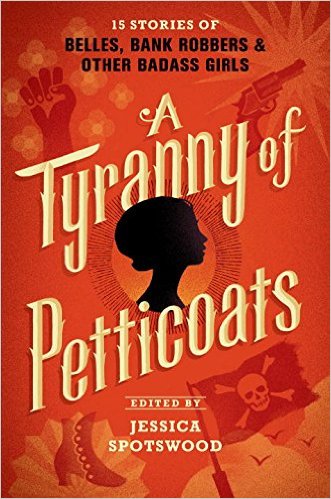A Tyranny of Petticoats: 15 Stories of Belles, Bank Robbers & Other Badass Girls
- By Jessica Spotswood
- Candlewick Press
- 368 pp.
- Reviewed by s.e. smith
- April 21, 2016
Despite big-name YA authors and a talented editor, this anthology is unfortunately uneven.

From pirates to pilots, thieves to spies, the girls in A Tyranny of Petticoats are fierce, independent, and resourceful. It’s no wonder, since the authors (including Beth Revis, Marie Lu, Andrea Cremer, and Marissa Meyer) of these stories are powerhouses of young-adult fiction known for their strong characters — and strong in the best sense of the word, because rather than falling into the trap of one-dimensional “just one of the boys” stereotypes, these women are tough in myriad ways.
Unfortunately, despite the book’s best efforts, few stories really stand out, and the overall impression is underwhelming. Perhaps individual tales would be stronger on their own, but don’t plan on reading the book straight through. Try sipping at stories here and there instead, and maybe you’ll have better results than I did.
That said, there are a few pieces in A Tyranny of Petticoats that caught my eye. One of these was J. Anderson Coats’ “Mother Carey’s Table,” an exploration of piracy, race, and superstition in 18th-century British North America. In it, our heroine enjoys the relative freedom piracy offers to her as a black girl in a world of slavery and oppression.
Here, all members of the crew are treated equally so long as they carry their weight, but she also lives in fear that she and her father will be seized as spoils and auctioned off along with the rest of the property on the ship. When her vessel faces off with a frigate, she knows she’s doomed — unless she takes an incredible risk and pays a terrible price for it.
It’s an interesting tale, reflecting research and an honest exploration of the social attitudes of the time. Mother Carey’s Table was famous among sailors of that era, and the structure of the story is otherworldly, eerie, and chilling.
I also have a soft spot for “Bonnie and Clyde,” Saundra Mitchell’s take on Depression-era Indiana. It was a time of intense privation for many people, with skyrocketing foreclosure rates as people struggled to meet even the most basic of needs.
When a young woman turns to bank robbery and acts as a sort of Robin Hood figure, it’s a thumbing of her nose at the establishment, even as it’s also incredibly dangerous. Explorations of class rarely show up in YA literature, and while the story treads some familiar ground, it raises interesting questions about gender and culture.
Lindsay Smith’s “City of Angels,” set in World War II Los Angeles on the grounds of an aircraft factory, also makes for intriguing reading about women in wartime, sexual awakening, and chasing dreams in Hollywood. The 1940s represented a fascinating era in the United States as the traditional order of things was disrupted.
It wasn’t just that women were entering the workforce, but also that more and more were entering the counterculture — the outspoken and adventurous women of the flapper days were evolving into a force for change in the 1940s that laid the groundwork for the explosion of feminism in the 1960s. “City of Angels” takes on the question of what happens when war upends tradition, and when love becomes lopsided, with one person investing far more in a relationship than the other is willing to commit.
While these three stories stand above the pack, some of the others struggle with structural and plotting issues. Short stories are notoriously unforgiving — the flaws can explode onto the page.
Some of the entries in Petticoats reflect a growing problem with YA in the United States: As the call for diverse books grows louder, so, too, does the tendency to shoehorn diversity in or slap it on as an afterthought. Diverse representations must be honest and authentic, and I’m not entirely sure that was achieved with some of the entries here, where, in more than one instance, diversity feels like a plot device.
A few stories also borrow heavily from marginalized cultures, sometimes to the extent of being highly appropriative, and in some instances, wildly mixing disparate elements from completely different cultures. It’s difficult to tell stories about real people and real identities, and not all of these stories are effective, even though the overall balance of authors includes some diversity (though it could have benefited from much more).
Anthology editors like Jessica Spotswood are challenged to balance themes, contributors, and the overall intent of the collection. At their best, anthologies shine, with each entry able to stand on its own. This, alas, is not one of those anthologies. For all that I wanted to engage with both the theme and the stories themselves, I found myself finishing it with a largely indifferent feeling.
s.e. smith is a reader, writer, journalist, editor, and itinerant troublemaker based in Northern California. You can follow @realsesmith, @sesmithreads, or both on Twitter to keep up with smith’s work and reading habits.

